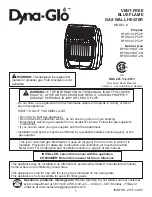
26
7. If improper venting is observed during any of the above tests,
the venting system must be corrected.
FAILURE TO CORRECT BACK DRAFTS MAY CAUSE AIR
CONTAMINATION AND UNSAFE CONDITIONS.
•
If the back draft cannot be corrected by the normal method or
if a suitable draft cannot be obtained, a blower type flue gas
exhauster must be employed to assure proper venting and
correct combustion.
CHECKING THE INPUT
Follow these instructions to determine the firing rate of the water
heater.
1. Follow the procedure described in the "Initial Start Up" section
on page 25 to measure the static and dynamic supply gas
pressures. Verify that the static and dynamic supply gas
pressures conform to the values listed in Table 3 on page 8.
2. Use this formula to “clock” the meter. Be sure that other gas
consuming appliances are not operating during this interval.
(3600/T) x H = Btuh
T = Time in seconds to burn one cubic foot of gas.
H = Btu’s per cubic foot of gas.
Btuh = Actual heater input.
Example: (BCL3100T1996NOX)
T = 18.1 seconds
H = 1000 BTU/Cu.Ft.
Btuh = (3,600/18.1) x 1,000 = 199,000
(Compare with BCL3100T1996NOX model and rating.)
UNDER NO CIRCUMSTANCES SHOULD THE GAS INPUT EXCEED
THE INPUT SHOWN ON THE HEATER'S RATING PLATE.
WATER TEMPERATURE ADJUSTMENT
Water temperature over 125°F (52°C)
can cause severe burns instantly
resulting in severe injury or death.
Children, the elderly and the
physically or mentally disabled are at
highest risk for scald injury.
Feel water before bathing or
showering.
Temperature limiting devices such as
mixing valves must be installed
when required by codes and to
ensure safe temperatures at fixtures.
The water temperature is controlled by a thermostat, Fig. 3,
which has two sensing elements. One sensor is located near the
top of the tank and the other is near the center. The thermostat
is set in the lowest position before the heater leaves the factory.
The thermostat temperature dial, Fig. 3, is accessible by
removing the control cover. The dial is adjustable and may be set
for 120°F (49°C) to 180°F (82°C) water temperature, but 120°F
(49°C) is the recommended starting point. It is suggested the dial
be placed on the lowest setting which produces an acceptable
hot water supply. This will always give the most energy efficient
operation. The temperature control has a 4°F fixed differential.
Supply gas pressure shall be measured while the water heater
is not firing (static pressure) and while the water heater is firing
at full capacity (dynamic pressure).
If the supply gas pressure to the water heater is not between
the required minimum and maximum values given in Table 3
on page 8 adjust the supply gas regulator as necessary. Adjust
the supply gas regulator(s) per the regulator manufacturer’s
instructions to achieve the required “static” and “dynamic”
supply gas pressure.
Multiple Water Heater Installations:
In multiple water heater installations or in installations where
the installed water heater(s) share a common gas supply main
with other gas fired appliances; the supply gas pressures shall
be measured at each water heater with all gas fired appliances
connected to a common main firing at full capacity.
On multiple water heater installations the supply gas line regulators
shall be adjusted to provide gas pressure to each water heater
within the minimum and maximum supply pressure requirements
listed in Table 3 on page 8 with all gas fired appliances connected
to a common gas main firing at full capacity.
NOTE:
A pressure drop of more than 1.5” W. C. (0.37 kPa)
when the Main Burner ignites is an indication of an inadequate
supply of gas and can lead to ignition failure, rough starts and/
or rough operation. If a drop of more than 1.5” W. C. (0.37 kPa)
in supply gas pressure occurs when the Main Burner ignites,
ensure the supply gas lines and regulator(s) are properly sized
and installed. See the requirements for Supply Gas Regulator
on page 12 and Gas Piping on page 24. Ensure all requirements
and installation instructions are maintained.
CHECKING VENTING
The following steps shall be followed with each appliance
connected to the venting system placed in operation, while any
other appliances connected to the venting system are not in
operation.
1. Seal any unused openings in the venting system.
2. Inspect the venting system for proper size and horizontal pitch, as
required in the National Fuel Gas Code, ANSI Z223.1or the CAN/
CGA B149 Installation Codes and these instructions. Determine
that there is no blockage or restriction, leakage, corrosion and
other deficiencies which could cause an unsafe condition.
3. So far as is practical, close all building doors and windows
and all doors between the space in which the water heater(s)
connected to the venting system are located and other spaces
of the building. Turn on all appliances not connected to the
venting system. Turn on all exhaust fans, such as range hoods
and bathroom exhausts, so they shall operate at maximum
speed. Close fireplace dampers.
4. Follow the lighting instruction. Place the water heater being
inspected in operation. Adjust thermostat so water heater
shall operate continuously.
5. Inspect vent system for leakage after 5 minutes of main burner
operation.
6. After it has been determined that each appliance connected
to the venting system properly vents when tested as outlined
above, return doors, windows, exhaust fans, fireplace
dampers and any other gas burning appliance to their previous
conditions of use.
Summary of Contents for (A)BCL3100T2506NOX
Page 50: ...NOTES 50 ...
















































